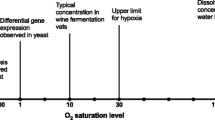Abstract
An overview is presented of the steady- and transient state kinetics of growth and formation of metabolic byproducts in yeasts.Saccharomyces cerevisiae is strongly inclined to perform alcoholic fermentation. Even under fully aerobic conditions, ethanol is produced by this yeast when sugars are present in excess. This so-called ‘Crabtree effect’ probably results from a multiplicity of factors, including the mode of sugar transport and the regulation of enzyme activities involved in respiration and alcoholic fermentation. The Crabtree effect inS. cerevisiae is not caused by an intrinsic inability to adjust its respiratory activity to high glycolytic fluxes. Under certain cultivation conditions, for example during growth in the presence of weak organic acids, very high respiration rates can be achieved by this yeast.S. cerevisiae is an exceptional yeast since, in contrast to most other species that are able to perform alcoholic fermentation, it can grow under strictly anaerobic conditions.
‘Non-Saccharomyces’ yeasts require a growth-limiting supply of oxygen (i.e. oxygen-limited growth conditions) to trigger alcoholic fermentation. However, complete absence of oxygen results in cessation of growth and therefore, ultimately, of alcoholic fermentation. Since it is very difficult to reproducibly achieve the right oxygen dosage in large-scale fermentations, non-Saccharomyces yeasts are therefore not suitable for large-scale alcoholic fermentation of sugar-containing waste streams. In these yeasts, alcoholic fermentation is also dependent on the type of sugar. For example, the facultatively fermentative yeastCandida utilis does not ferment maltose, not even under oxygen-limited growth conditions, although this disaccharide supports rapid oxidative growth.
Similar content being viewed by others
References
Andreasen AA & Stier TJB (1953) Anaerobic nutrition ofSaccharomyces cerevisiae. I. Ergosterol requirement for growth in a defined medium. J. Cell. Comp. Physiol. 41: 23–26.
Andreasen AA & Stier TJB (1954) Anaerobic nutrition ofSaccharomyces cerevisiae. II. Unsaturated fatty acid requirement for growth in a defined medium. J. Cell. Comp. Physiol. 43: 271–281
Bruinenberg PM, de Bot PHM, van Dijken JP & Scheffers WA (1984) NADH-linked aldose reductase: the key to anaerobic alcoholic fermentation of xylose by yeasts. Appl. Microbiol. Biotechnol. 19: 256–260
D'Amore T & Stewart GG (1987) Ethanol tolerance of yeast. Enzyme Microb. Technol. 9: 322–330.
Käppeli O (1986) Regulation of carbon metabolism inSaccharomyces cerevisiae and related yeasts. Adv. Microb. Physiol. 28: 181–209
Parulekar SJ, Semones GB, Rolf MJ, Lievense JC & Lim HC (1986) Induction and elimination of oscillations in continuous cultures inSaccharomyces cerevisiae. Biotechnol. Bioeng. 28: 700–710
Petrik M, Käppeli O & Fiechter A (1983) An expanded concept for the glucose effect in the yeastSaccharomyces uvarum: involvement of short- and long-term regulation. J. Gen. Microbiol. 129: 43–49
Postma E, Scheffers WA & van Dijken JP (1988) Adaptation of the kinetics of glucose transport to environmental conditions in the yeastCandida utilis CBS 621: a continuous culture study. J. Gen. Microbiol. 134: 1109–1116
Postma E, Kuiper A, Tomasouw WF, Scheffers WA & van Dijken JP (1989a) Competition for glucose between the yeastsSaccharomyces cerevisiae andCandida utilis. Appl. Env. Microbiol. 55: 3214–3220
Postma E, Verduyn C, Scheffers WA & van Dijken JP (1989b) Enzymic analysis of the Crabtree effect in glucose-limited chemostat cultures ofSaccharomyces cerevisiae. Appl. Environ. Microbiol. 55: 468–477
Rieger M, Käppeli O & Fiechter A (1983) The role of a limited respiration in the incomplete oxidation of glucose bySaccharomyces cerevisiae. J. Gen. Microbiol. 129: 653–661
Romanos MA, Scorer CA & Clare JJ (1992) Foreign gene expression in yeast: a review. Yeast 8: 423–488
Schatzmann H (1975) Anaerobes Wachstum vonSaccharomyces cerevisiae. Thesis, Eidgenössische Hochschule Zürich, Switzerland
Sims AP & Barnett JA (1978) The requirement of oxygen for the utilization of maltose, cellobiose and D-galactose by certain anaerobically fermenting yeasts (Kluyver effect). J. Gen. Microbiol. 106: 277–288
Van Dijken JP & Scheffers WA (1986) Redox balances in the metabolism of sugars by yeasts. FEMS Microbiol. Rev. 32: 199–224
Van Dijken JP, van den Bosch JJ, Hermans L, de Miranda R & Scheffers WA (1986) Alcoholic fermentation by ‘non-fermentative’ yeasts. Yeast 2: 123–127
Van Urk H, Postma E, Scheffers WA & van Dijken JP (1989a) Glucose transport in Crabtree-positive and Crabtree-negative yeasts. J. Gen. Microbiol. 135: 2399–2406
Van Urk H, Schipper D, Breedveld GJ, Mak PR, Scheffers WA & van Dijken JP (1989b) Localization and kinetics of pyruvate-metabolizing enzymes in relation to aerobic alcoholic fermentation inSaccharomyces cerevisiae CBS 8066 andCandida utilis CBS 621. Biochim. Biophys. Acta 992: 78–86
Van Urk H, Voll WSL, Scheffers WA & van Dijken JP (1990) Transient-state analysis of metabolic fluxes in Crabtree-positive and Crabtree-negative yeasts. Appl. Environ. Microbiol. 56: 281–287
Verduyn, C, Zomerdijk TPL, van Dijken JP & Scheffers WA (1984) Continuous measurement of ethanol production by aerobic yeast suspensions with an enzyme electrode. Appl. Microbiol. Biotechnol. 19: 181–185
Verduyn C, Postma E, Scheffers WA & van Dijken JP (1990a) Physiology ofSaccharomyces cerevisiae in anaerobic glucoselimited chemostat cultures. J. Gen. Microbiol. 136: 395–403
Verduyn C, Postma E, Scheffers WA & van Dijken JP (1990b) Energetics ofSaccharomyces cerevisiae in anaerobic glucoselimited chemostat cultures. J. Gen. Microbiol. 136: 405–412
Verduyn C (1991) Physiology of yeasts in relation to growth yields. Antonie van Leeuwenhoek 60: 325–353
Verduyn C, Postma E, Scheffers WA & van Dijken JP (1992a) Effect of benzoic acid on metabolic fluxes in yeasts: a continuous culture study on the regulation of respiration and alcoholic fermentation. Yeast 8: 501–517
Verduyn C (1992b) Energetic aspects of metabolic fluxes in yeasts. Thesis, Delft University of Technology, The Netherlands
Visser W, Scheffers WA, Batenburg-van der Vegte WH & van Dijken JP (1990) Oxygen requirements of yeasts. Appl. Environ. Microbiol. 56, 3785–3792
Von Meyenburg HK (1969) Energetics of the budding cycle ofSaccharomyces cerevisiae during glucose-limited aerobic growth. Arch. Microbiol. 66: 289–303
Author information
Authors and Affiliations
Rights and permissions
About this article
Cite this article
van Dijken, J.P., Weusthuis, R.A. & Pronk, J.T. Kinetics of growth and sugar consumption in yeasts. Antonie van Leeuwenhoek 63, 343–352 (1993). https://doi.org/10.1007/BF00871229
Issue Date:
DOI: https://doi.org/10.1007/BF00871229



